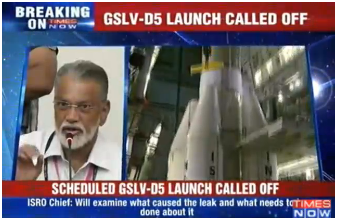
India's efforts to power Geosynchronous Satellite Launch Vehicle with indigenous cryogenic engine continue to be jinxed. The Indian Space Research Organisation (Isro) on Monday evening called off the launch of GSLV-D5 after scientists detected a leak in the second stage liquid propellant tank.
The mood at the Satish Dhawan Space Centre at Sriharikota changed from anticipation to disappointment within minutes. The mission was called off an hour and 14 minutes before the designated lift-off at 4.50pm. GSLV-D5, powered by an indigenous cryogenic engine, was to launch telecommunication satellite GSAT-14.
"...we detected a leak in the fuel system of the second stage of the vehicle. We are calling off the launch," Isro chairman K Radhakrishnan said.
He told TOI that scientists were draining nitrogen tetroxide fuel from the second stage remotely as it was unsafe to go near the launch pad.
Scientists will also drain out highly combustible liquid hydrogen and liquid oxygen from the cryogenic engine. "We need to look at what went wrong and what action needs to be taken before further preparations for the launch," Radhakrishnan said.
Asked if the leak posed a threat to the vehicle while it was at the launch pad, a scientist said it would be assessed only after studying the vehicle further.
The rocket will be taken to the vehicle assembly building where a close inspection will be carried out to ascertain the damage.
The GSLV-D5 launch is crucial as it would demonstrate the country's ability to develop and use cryogenic engines that are inevitable for the launch of big telecommunication satellites and Isro's ambitious projects, including manned missions.
PSLVs, which India has mastered, can carry only satellites weighing less than 1,500kg.
The Satish Dhawan Space Centre in Sriharikota remained tense since Sunday 11.50am when the countdown began.
Weighing on the scientists mind were two consecutive failures of GSLVs in 2010. The April 15 failure of GSLV-D3 meant the first attempt with an indigenous engine had come a cropper.
Scientists remained confident till about 3.45pm, when the leak was noticed.

